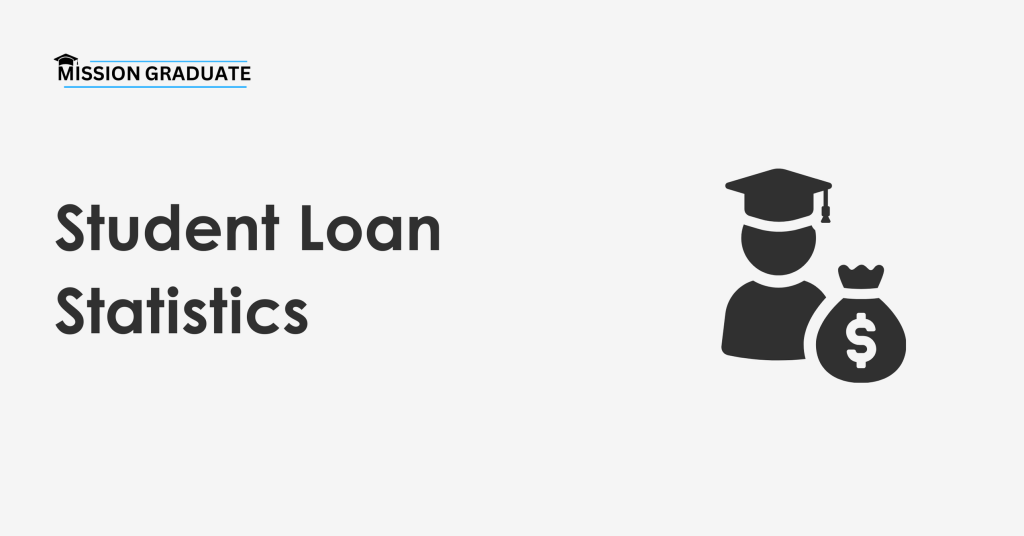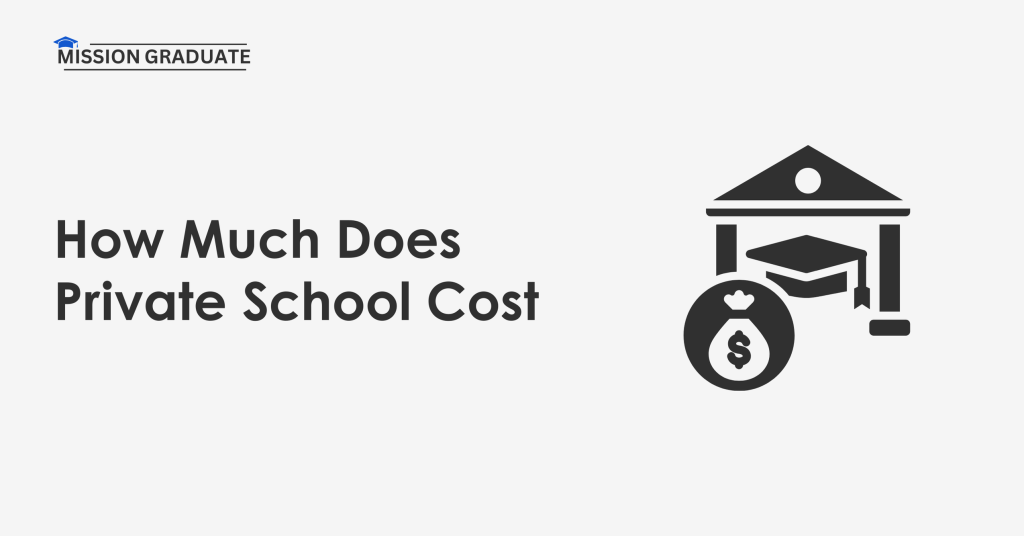Over 87% of adults aged 15 and above are literate globally, and most countries worldwide have a literacy rate of 95%.
However, these stats mask the facts about illiteracy. For instance, nearly three-fourths of the adults in the sub-Saharan African region do not possess the basic skills to read and write.
Further, 79% of the adults aged 15 and above in the United States are literate, and the average American reads at the 7th- to 8th-grade level.
Let’s explore more details about the global literacy rates, US literacy rates, child and adult literacy rates, literacy rates by gender, race, state, country, and region, and the impacts of illiteracy.
Literacy Statistics 2025 (Editor’s Picks)
- The global adult literacy rate in 2022 was 87%.
- 90.31% of men aged 15 years and older worldwide are literate, while 83.78% of global female adults are literate.
- The sub-Saharan African region has the highest illiteracy rates worldwide at 32.28%.
- 79% of the US adults in the United States were literate in 2022.
- 25% of the children in the United States grow up without being able to read.
- United States has a literacy rate of 88% for adults aged 18 years and older.
- 7 countries worldwide, including Finland, Norway, Luxembourg, Andorra, Greenland, Liechtenstein, and Uzbekistan, have a literacy rate of 100%.
- New Hampshire has the highest literacy rate in the United States at 94.2%, while Niger has the lowest literacy rate with just 19.19%.
Global Literacy Rate
87% of adults worldwide aged 15 years or older are literate, according to 2022 data.
Comparatively, 86.85% of adults aged 15 years or older in 2021 were Literate. That means the literacy rate increased by 0.16% compared to the previous year.
Besides, the literacy rate worldwide was recorded to be 86.71 % and 86.49% in 2020 and 2019, respectively.
The global literacy rates among adults grew by 20.01% between 1976 and 2022.
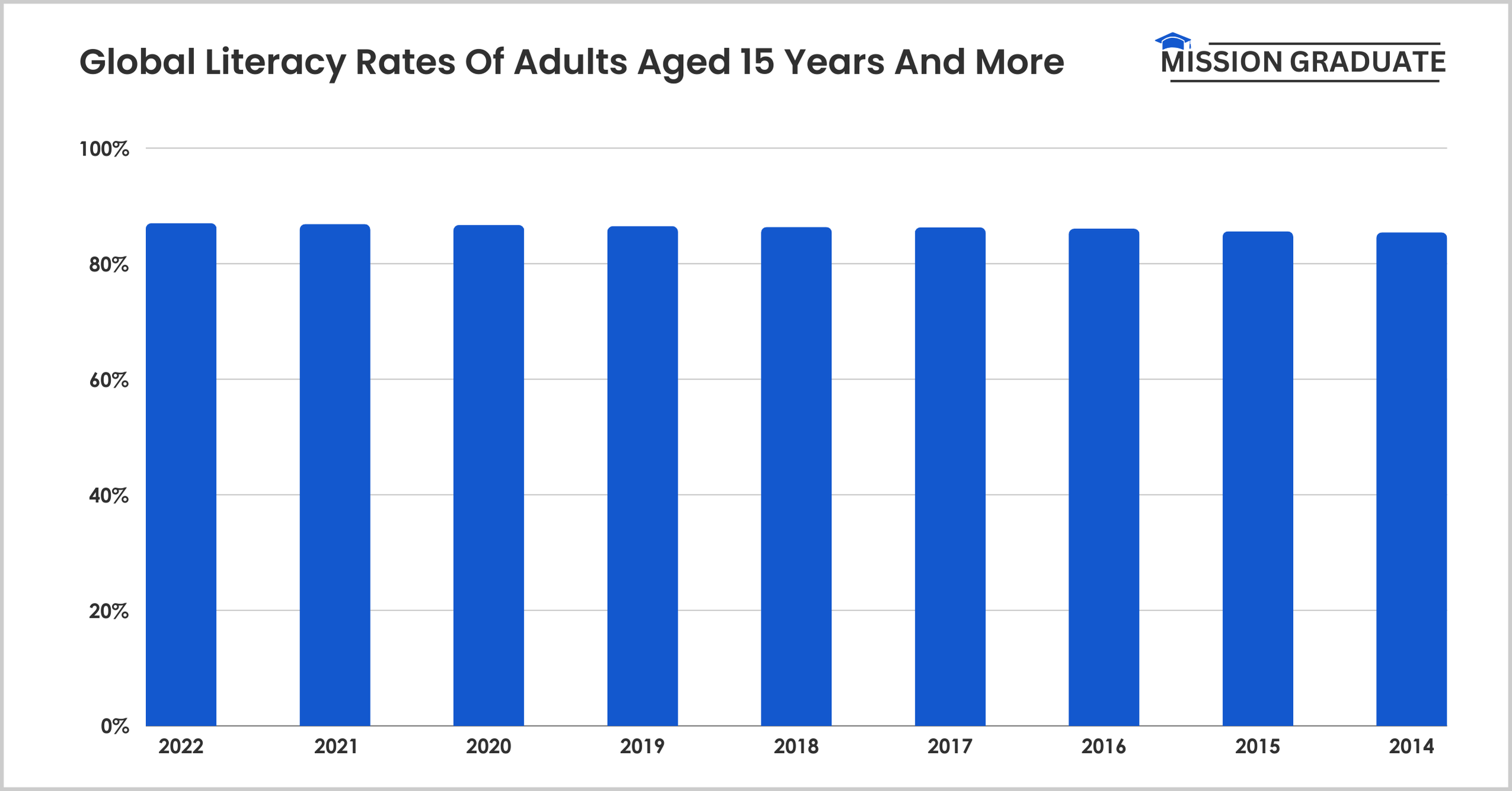
The following table displays the global literacy rates of adults aged 15 years and more recorded over the years.
| Year | Global Literacy Rates |
|---|---|
| 2022 | 87.01% |
| 2021 | 86.85% |
| 2020 | 86.71% |
| 2019 | 86.49% |
| 2018 | 86.34% |
| 2017 | 86.29% |
| 2016 | 86.06% |
| 2015 | 85.6% |
| 2014 | 85.43% |
| 2013 | 84.86% |
| 2012 | 84.76% |
| 2011 | 84.32% |
| 2010 | 84.16% |
Source: Statista, Our World Data.
U.S. Literacy Rates
On average, 79% of the US adults were literate nationwide in 2022.
Meanwhile, 21% of the adults in the United States in 2022 were illiterate.
54% of the adults, or 130 Americans, were found to have a literacy rate below sixth grade. Besides, the average American has the potential to read at the 7th to 8th-grade level.
Source: Cross River Therapy, Literacy Gap Map.
Child Literacy Rates
1 in 4 children in the United States grew up unable to read.
Besides, 34% of the fourth graders have a reading level lower than the basic level, while 31% of students have a reading level below the proficient level.
Additionally, around 27% of eighth-grade students have a reading level below the basic level, and 39% can read below the proficient level.
On the other hand, 40% of the children in the United States can not read efficiently.
Source: Bright Future, Regis College, Scientific American.
Children surrounded by adults with low literacy rates are 72% more likely to have a low reading level in school.
2 out of 10 students start kindergarten with 2 to 3 year less skills than their grade level. Meanwhile, another 2 in 10 students start with a year lower skills than their grade peers.
As a result, the students who are behind make only a year’s progress in each grade level, keeping them behind their peers throughout their schools. At times, these children are more likely to repeat grades.
Source: Regis College
Over half of the Black fourth-grade children score less than a basic reading level.
Ethnicity is a significant factor affecting the literacy rates of children in the United States.
52% of the Black students in the US have poor reading skills. Meanwhile, 45% of Hispanic fourth graders have reading levels that are below basic.
On the other hand, just 23% of white students have below basic reading levels in the United States.
Source: Regis College.
Only 20% of the 4th-grade children from lower-income households have reading proficiency.
Comparatively, 51% of the 4th-grade children from higher-income households have reading proficiency.
Students from lower-income households are less likely to be proficient in reading. Household incomes largely affect the reading proficiency and literacy rates of children.
Florida has the highest percentage of students with reading proficiency among lower-income students at 27%.
On the other hand, Massachusetts has the highest reading proficiency among fourth-grade, higher-income household children at 62%.
Source: Bright Future.
Massachusetts has the highest percentage of children who scored at or above reading proficiency at 47%.
Only 53% of the students in the state were not proficient in reading. Maryland follows Massachusetts with the second-highest percentage of students that were proficient in reading, at 45%.
Other states that have the most reading proficiency among children are New Hampshire, Virginia, and Connecticut.
Here is a table displaying the U.S. states with the highest reading proficiency among fourth-grade students.
| State | Students Not Reading Proficiently | Lower-income Students Not Reading Proficiently | Higher Income Students Not Reading Proficiently |
|---|---|---|---|
| Massachusetts | 53% | 75% | 38% |
| Maryland | 55% | 76% | 42% |
| New Hampshire | 55% | 76% | 47% |
| Virginia | 57% | 79% | 44% |
| Connecticut | 57% | 81% | 43% |
| Vermont | 58% | 74% | 46% |
| New Jersey | 58% | 78% | 44% |
| Colorado | 59% | 79% | 54% |
| Minnesota | 59% | 77% | 48% |
| Pennsylvania | 60% | 77% | 45% |
| Washington | 60% | 77% | 47% |
| Florida | 61% | 73% | 42% |
| Delaware | 62% | 75% | 48% |
| Rhode Island | 62% | 81% | 45% |
Source: Bright Future.
New Mexico has the lowest reading proficiency among 4th-grade children in the United States, with just 21% of children.
Mississippi also has the 21% of the overall reading proficiency among children. However, higher-income children have lower reading proficiency in New Mexico.
Other states with lower reading proficiency among 4th-grade students are Louisiana, the District of Columbia, and Alaska.
The following table displays the states with the lowest reading proficiency among 4th-grade children in the United States by State.
| State | Students Not Reading Proficiently | Lower-income Students Not Reading Proficiently | Higher Income Students Not Reading Proficiently |
|---|---|---|---|
| New Mexico | 79% | 85% | 61% |
| Mississippi | 79% | 85% | 58% |
| Louisiana | 77% | 85% | 58% |
| District of Columbia | 77% | 87% | 39% |
| Alaska | 73% | 85% | 60% |
| California | 73% | 85% | 54% |
| Nevada | 73% | 83% | 56% |
| West Virginia | 73% | 76% | 63% |
| Arizona | 72% | 85% | 57% |
| South Carolina | 72% | 83% | 54% |
| Texas | 72% | 83% | 53% |
| Hawaii | 70% | 83% | 57% |
| Oklahoma | 70% | 79% | 57% |
| Alabama | 69% | 82% | 51% |
Source: Bright Future.
Adult Literacy Rates
The literacy rate of adults aged 18 years and older is 88% in the United States.
Besides, 80% of the adults aged 18 and over in the United States have medium to high proficiency in the English language.
The literacy rates of adults in the United States vary according to the number of immigrants residing in that area or state.
The states with large numbers of illegal immigrants have a 60% higher chance of literacy rates being lower by 20% for the adult population.
Source: Cross River Theraphy.
77 million adults in the United States lack the literacy necessary for most jobs.
Besides, 46% of the adults do not understand basic financial documents like balance sheets and income statements.
Plus, 75% of the Americans receiving food stamps are found to have the lowest two levels of literacy in the country.
Source: Bright Future.
Adult literacy rates in the United States have declined by 6.64% between 2020 and 2022.
In 2020, the literacy rate of adults aged 15 and older was 85.64%, declining to 79% in 2022.
Comparatively, 83.30% of the adults aged 15 years and older were literate. This shows that the literacy rates in the United States declined between 2020 and 2022, while the literacy rates steadily increased before 2020.
The pandemic is considered a major reason for this decline, as the students lost nearly half or more of their academic year’s learning and reading instructions.
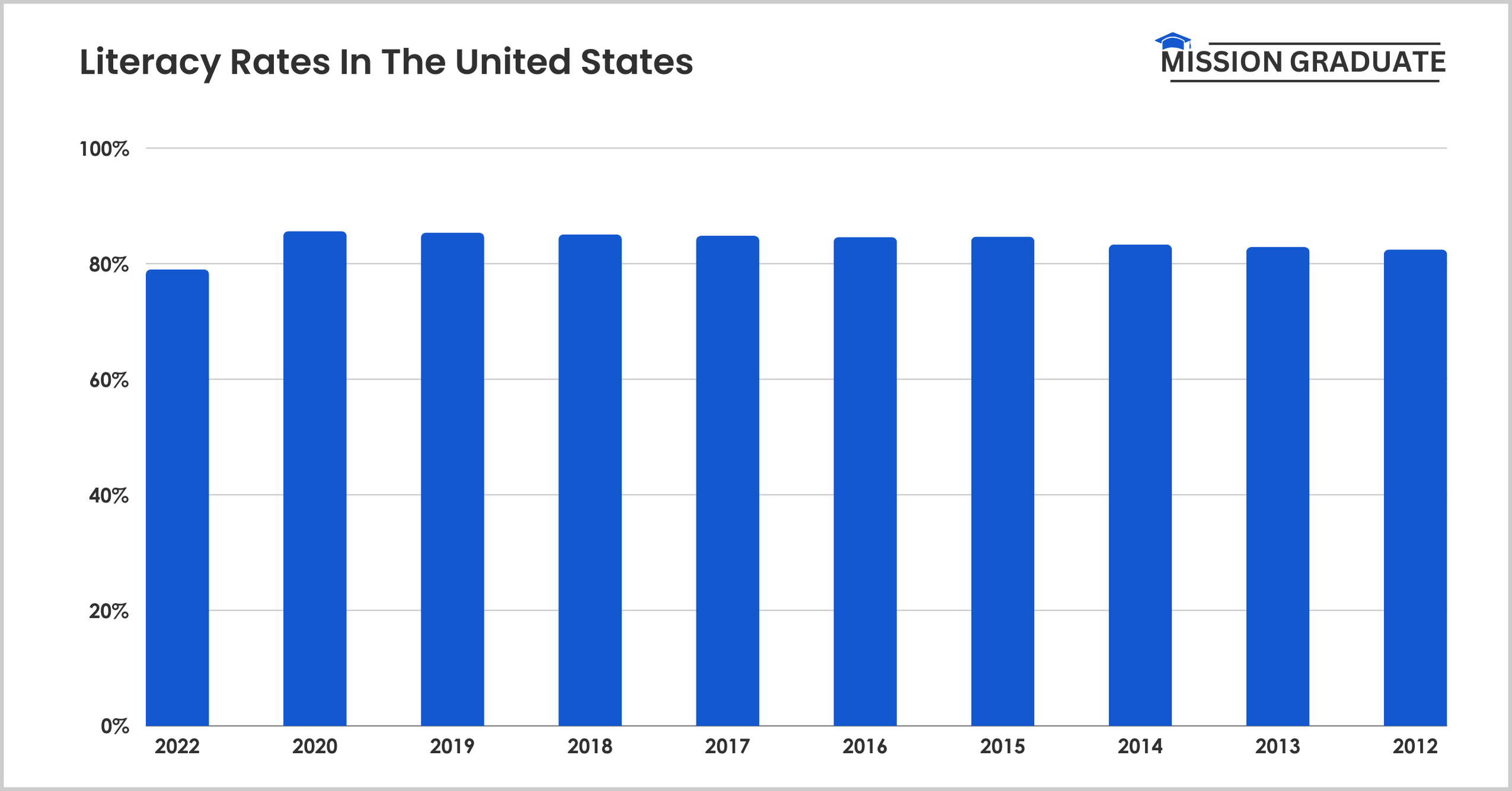
The following table displays the literacy rates in the United States recorded over the years.
| Year | Literacy Rates In The United States |
|---|---|
| 2022 | 79% |
| 2020 | 85.64% |
| 2019 | 85.36% |
| 2018 | 85.07% |
| 2017 | 84.83% |
| 2016 | 84.61% |
| 2015 | 84.69% |
| 2014 | 83.30% |
| 2013 | 82.88% |
| 2012 | 82.44% |
Source: Trading Economic.
Literacy Statistics By Gender
90.31% of men aged 15 years and older worldwide are literate, while 83.78% of global female adults are literate.
This data highlights 6.53% of the literacy gap between the global men and female adults aged 15 years and older.
However, this literacy gap was 18.05% in 1976 and 10.59% in 2000.
Besides, men had a literacy rate of 90.22%, and women had a literacy rate of 83.51% in 2021.
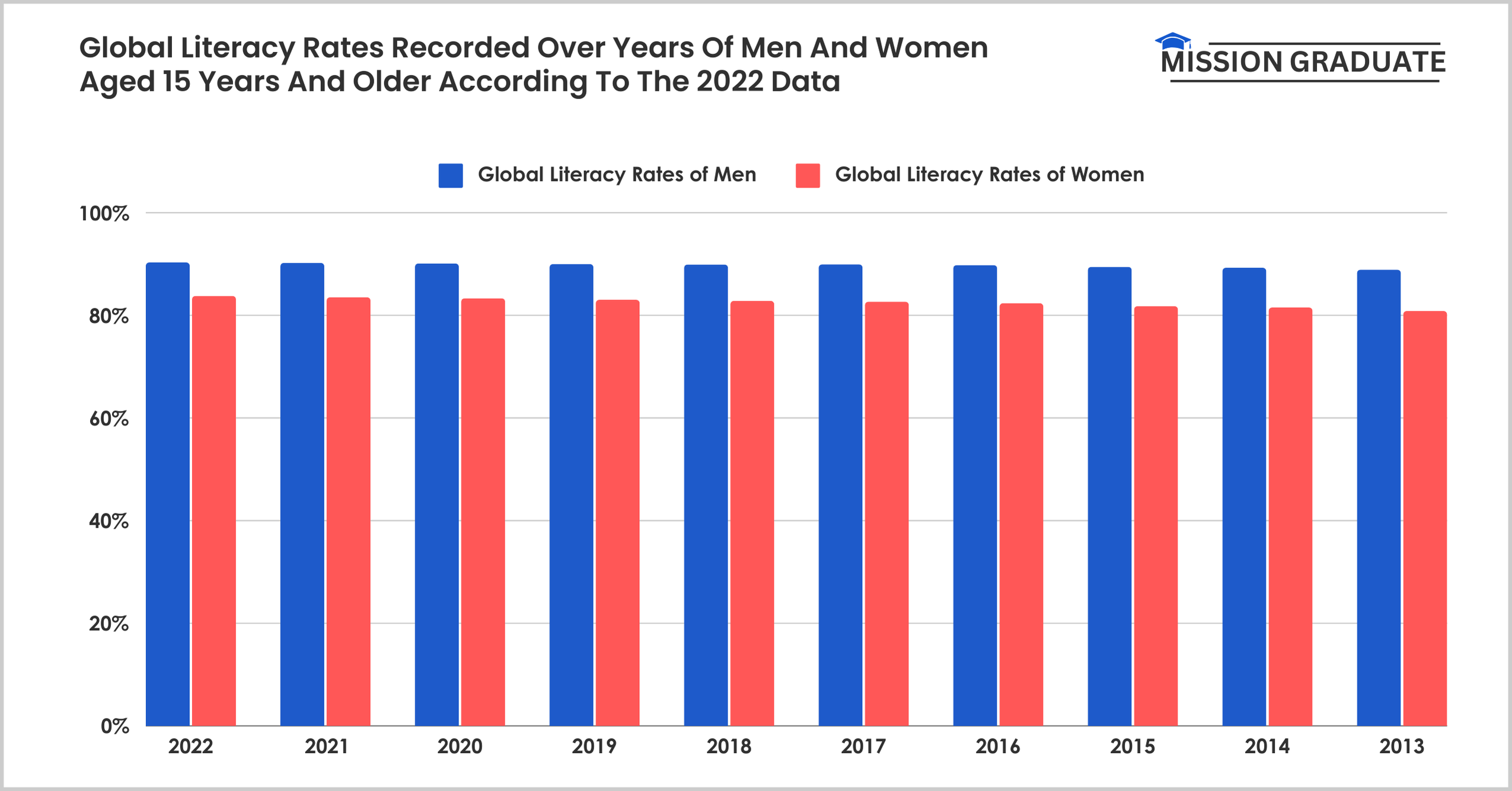
The following table displays the global literacy rates recorded over years of men and women aged 15 years and older according to the 2022 data.
| Year | Global Literacy Rates Of Men | Global Literacy Rates Of Women |
|---|---|---|
| 2022 | 90.31% | 83.78% |
| 2021 | 90.22% | 83.51% |
| 2020 | 90.11% | 83.33% |
| 2019 | 89.98% | 83.02% |
| 2018 | 89.91% | 82.81% |
| 2017 | 89.93% | 82.66% |
| 2016 | 89.8% | 82.35% |
| 2015 | 89.44% | 81.79% |
| 2014 | 89.27% | 81.52% |
| 2013 | 88.9% | 80.84% |
| 2012 | 88.86% | 80.7% |
| 2011 | 88.45% | 80.25% |
| 2010 | 88.39% | 79.96% |
Source: Statista.
Literacy Statistics By Race
35% of White Americans have low English literacy skills.
Of these, 2% of the white Americans are born outside the United States.
Besides, 23% of the Black residents in the United States have low English literacy skills. Of these, 3% of Black Americans are born outside the United States.
34% of non-US-born adults in the country have low literacy skills.
The following table displays the percentage of Americans with low English literacy skills by race as of 2022.
| Race/ Ethnicity | Percentage Of Americans With Low English Literacy Skills | Percentage Of Americans With Low English Literacy Skills Born Outside Of America |
|---|---|---|
| White | 35% | 2% |
| Black | 23% | 3% |
| Hispanic | 34% | 24% |
| Other races/ethnicities | 8% | – |
| Non-U.S.-born adults | 34% | – |
Source: World Population Review.
82% of Asian Americans have basic reading skills, while 57% have proficient-level reading skills.
The highest percentage of Asian adults in the United States had grade-four reading skills. At the same time, 44% of White Americans have proficient-level reading skills.
Meanwhile, the lowest percentage of Black Americans had grade-four reading skills.
The following table displays the proficiency level of reading skills among different races as of data recorded in 2019.
| Race / Ethnicity | Proficient Level | Basic Level |
|---|---|---|
| Asian | 57% | 82% |
| White | 44% | 76% |
| Native Hawaiian/Pacific Islander | 24% | 55% |
| Hispanic | 23% | 54% |
| American Indian/Alaska Native | 20% | 50% |
| Black | 18% | 47% |
| Two or more races | 40% | 72% |
Source: NCES.
US Literacy Rates By State
New Hampshire has the highest literacy rate in the United States at 94.2%.
Minnesota closely follows with a literacy rate of 94.0%, while North Dakota comes in third with a literacy rate of 93.7%.
Other states with the highest literacy rates in the United States are Vermont and South Dakota.
The following table displays the states with the highest literacy rates in the United States.
| US State | Literacy Rate Of The State |
|---|---|
| New Hampshire | 94.2% |
| Minnesota | 94.0% |
| North Dakota | 93.7% |
| Vermont | 93.4% |
| South Dakota | 93.0% |
| Nebraska | 92.7% |
| Wisconsin | 92.7% |
| Maine | 92.6% |
| Missouri | 92.5% |
| Iowa | 92.5% |
| Kansas | 92.2% |
| Indiana | 92.0% |
| Michigan | 91.7% |
| Rhode Island | 91.5% |
| Connecticut | 91.4% |
Source: Data Pandas.
California has the lowest literacy rate in the United States at 76.9%.
New York follows California with a literacy rate of 77.9%, while Florida has the third-lowest literacy rate of 80.3%.
Texas, New Jersey, and Georgia are the other states with the lowest literacy rates in the United States.
| US State | Literacy Rate |
|---|---|
| California | 76.9% |
| New York | 77.9% |
| Florida | 80.3% |
| Texas | 81.0% |
| New Jersey | 83.1% |
| Georgia | 83.3% |
| New Mexico | 83.5% |
| Nevada | 83.9% |
| Louisiana | 84.0% |
| Mississippi | 84.0% |
| Hawaii | 84.1% |
| Alabama | 85.2% |
| South Carolina | 85.3% |
| Arkansas | 86.3% |
| North Carolina | 86.4% |
Source: Data Pandas.
Literacy Rate By Country
According to the latest data, 7 countries worldwide have a literacy rate of 100%.
Besides, the United States ranks 36th with a literacy rate of 99%. Japan, Germany, the United Kingdom, France, Canada, Australia, Netherlands, etc, also have a literacy rate of 99%.
China and India, the most populous countries worldwide, have a literacy rate of 96.36% and 72.23%, ranking at 89th and 172nd, respectively.
The following table displays the countries with the highest literacy rates worldwide.
| Country | Literacy Rate Of Adults Aged Over 15 Years |
|---|---|
| Finland | 100% |
| Norway | 100% |
| Luxembourg | 100% |
| Andorra | 100% |
| Greenland | 100% |
| Liechtenstein | 100% |
| Uzbekistan | 100% |
| Latvia | 99.89% |
| Estonia | 99.82% |
| Lithuania | 99.82% |
| Azerbaijan | 99.81% |
| Guam | 99.79% |
| Kazakhstan | 99.79% |
| Poland | 99.79% |
| Tajikistan | 99.78% |
Source: Data Pandas.
Niger has the lowest literacy rate worldwide, with just 19.10% of the literacy rate.
Africa and Middle Eastern countries have the lowest literacy rates worldwide. Niger has the worst literacy rate worldwide and is followed by Guinea, with a literacy rate of 30.47%.
The following table displays the countries with the lowest literacy rates worldwide.
| Country | Literacy Rates |
|---|---|
| Niger | 19.10% |
| Guinea | 30.47% |
| South Sudan | 31.98% |
| Mali | 33.07% |
| Central African Republic | 36.75% |
| Burkina Faso | 37.75% |
| Somalia | 37.80% |
| Afghanistan | 38.17% |
| Benin | 38.45% |
| Chad | 40.02% |
| Ivory Coast | 43.27% |
| Liberia | 47.60% |
Source: Data Pandas.
Literacy Rates By Region
The sub-Saharan African region has the highest illiteracy rates worldwide at 32.28%.
Other regions with high illiteracy rates are South Asia, the Middle East, and North Africa.
Conversely, North America has the lowest illiteracy rate among adults aged 15 years and above. Latin America and the Caribbean, East Asia and the Pacific, and Europe and Central Asia have lower illiteracy rates.
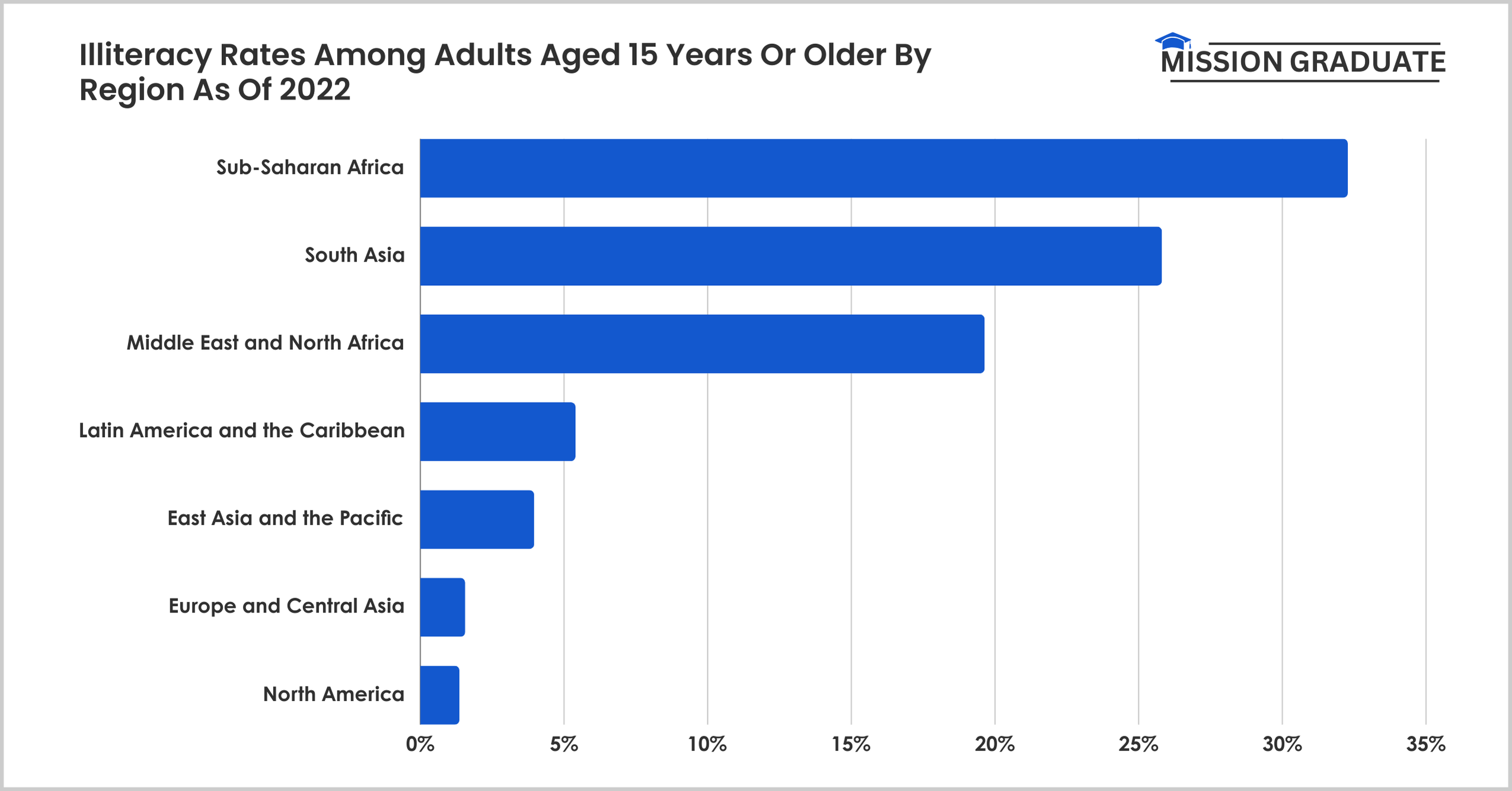
The following table displays the illiteracy rates among adults aged 15 years or older by region as of 2022.
| Region | Illiteracy Rates Among Adults |
|---|---|
| Sub-Saharan Africa | 32.28% |
| South Asia | 25.81% |
| Middle East and North Africa | 19.64% |
| Latin America and the Caribbean | 5.4% |
| East Asia and the Pacific | 3.96% |
| Europe and Central Asia | 1.56% |
| North America | 1.36% |
Source: Statista.
What Are The Impacts Of Illiteracy?
Illiteracy can severely impact the lives of adults as well as students. Children with low literacy rates are more likely to drop out of schools and colleges and, as a result, may have bad behavior, unstable careers, poor financial conditions, etc.
- 50% of the adults with low literacy do not have a job.
- 19% of the high school graduates can not read.
- 75% of the people on welfare can’t read.
- 43% of the adults that have low literacy have to stay in poverty.
- 1 in 5 people in the United States have reading skills below the level required to earn a living.
- Due to illiteracy, American taxpayers lose approximately $20 billion annually.
- 75% of the people in prison stated that they had not completed high school.
- Around 66% of the students who cannot read proficiently are more likely to end up in jail or welfare by the end of the 4th grade.
- 17 in 20 juvenile offenders were found to have low literacy rates.
- Half of the adults in the United States find it difficult to read a book with an 8th-grade level reading.
- $240 billion in social service expenditures and tax revenues are lost in the United States due to school dropouts.
- Around 16.67% of children who do not read proficiently in 3rd grade are less likely to graduate successfully from high school. That is 4 times greater rate than the ones with proficient reading skills.
Source: Bright Futures, Orton Gillingham Online Academy.
More Reads:
- eLearning Statistics
- College Students And Depression Statistics
- College Graduation Statistics
- College Enrollment Statistics
Conclusion: US Has Literacy Rate of 79%
Literacy statistics offers powerful insights into global progress. The figures conclude that the literacy rates worldwide are increasing and more people are getting educated. However, 773 million adults worldwide are still illiterate, and most of them are women, especially in low-income countries.
On the other hand, the literacy rates of adults aged 15 and above in the United States are seen to decline from 85.64% in 2020 to 79% in 2022.
Hence, it will be fascinating to observe whether the literacy rate in the US will increase in the upcoming years and cross the global average or if it decline further.
